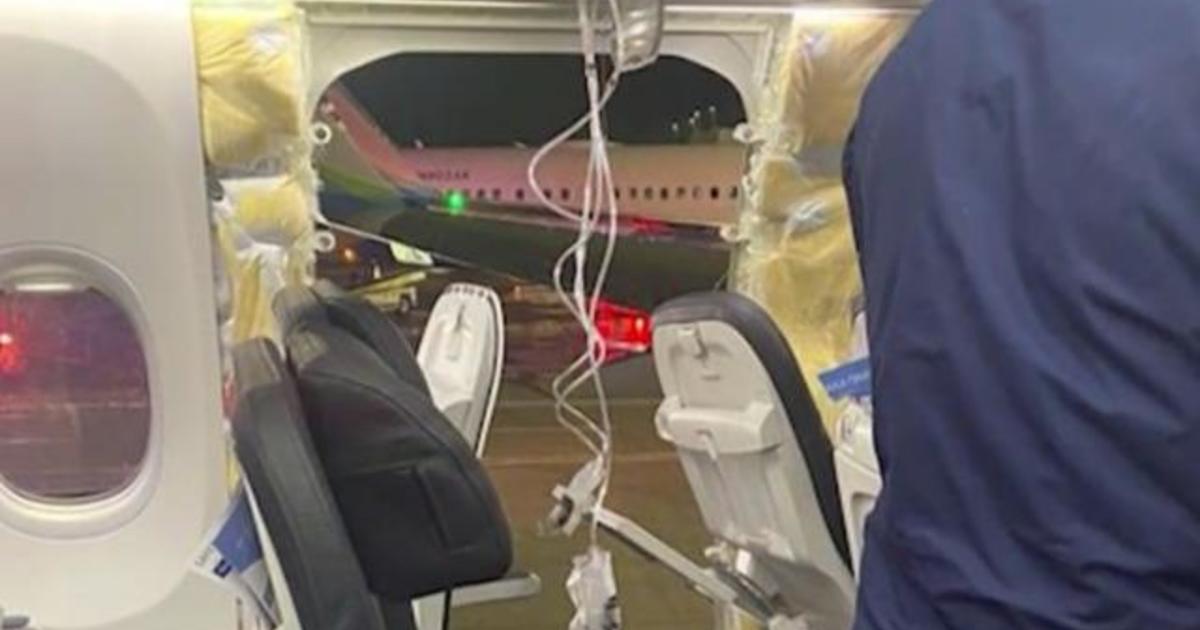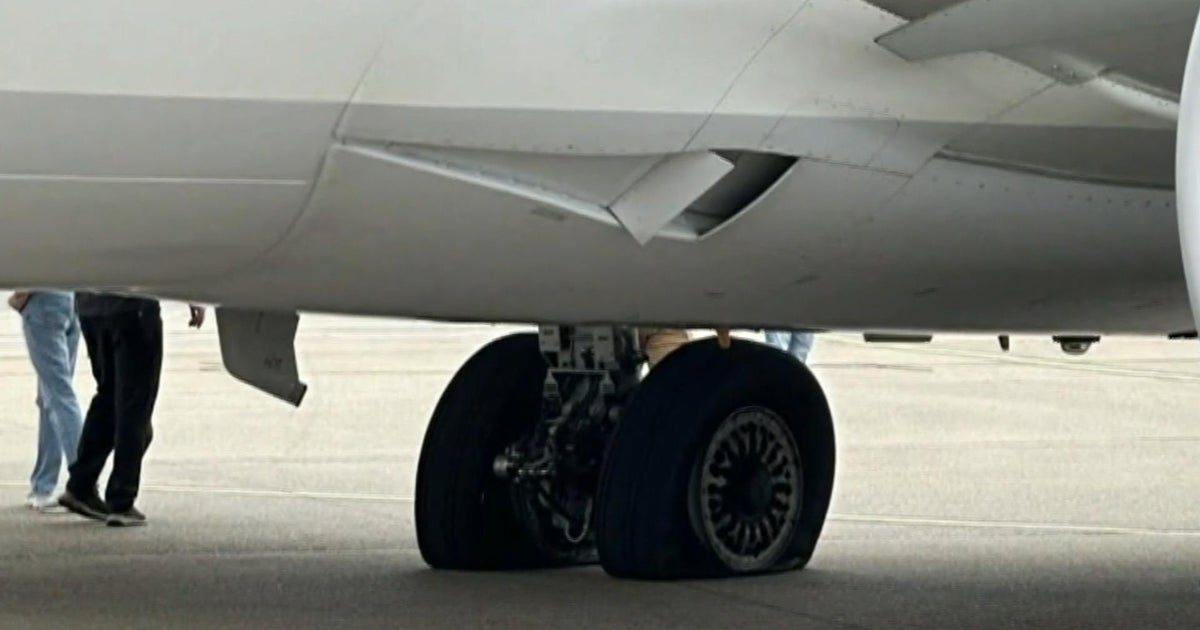CBS News
7 Alaska Airlines passengers sue over mid-air blowout, claiming “serious emotional distress”

A passenger on the Alaska Airlines flight that had to make an emergency landing after a door plug blew off mid-flight claims he was only saved from being sucked out of the hole by his seatbelt.
The passenger, Cuong Tran, was sitting in row 27 of Alaska Airlines flight 1242, immediately behind the door plug that gave way minutes after the Boeing 737 Max 9 plane departed Portland International Airport on January 5, according to the lawsuit, which was filed Thursday in King County Superior Court.
Tran, as well as six additional passengers on the flight, are suing Alaska Airlines, Boeing and door plug manufacturer Spirit Aerosystems, claiming the event left them with physical injuries and “serious emotional distress, fear, and anxiety.” The claims follow an earlier lawsuit from three other passengers on the same flight, who are suing Boeing and the airline for $1 billion, claiming negligence caused the incident.
In the latest lawsuit, the plaintiffs are seeking punitive, compensatory and general damages, although the lawsuit doesn’t specify an amount.
Wisner Baum
When the door plug blew out, Tran’s shoes and socks were torn from his feet, according to an emailed statement from his attorney. His legs were pulled toward the hole, jerking his leg and causing it to get trapped in the seat structure in front of him. His seatbelt kept him from being sucked out of the plane, he added.
“Our clients — and likely every passenger on that flight— suffered unnecessary trauma due to the failure of Boeing, Spirit AeroSystems, and Alaska Airlines to ensure that the aircraft was in a safe and airworthy condition,” said trial attorney Timothy A. Loranger in the statement.
Five other passengers, a family from Claremont, California, feared for their lives when the hole opened up on the side of the airplane, the lawyer said. The parents, Ket Tran and Tram Vo, and their three sons are now in counseling to deal with the trauma, Loranger added.
The seventh passenger who is suing, Huy Tran, was seated next to his friend Cuong Tran in Row 27, the lawyers said.
Wisner Baum
Boeing declined to comment, while Spirit Aerosystems and Alaska Airlines didn’t immediately return a request for comment.
CBS News
The Menendez Brothers’ Fight for Freedom

Watch CBS News
Be the first to know
Get browser notifications for breaking news, live events, and exclusive reporting.
CBS News
9/28: CBS Weekend News – CBS News

Watch CBS News
Be the first to know
Get browser notifications for breaking news, live events, and exclusive reporting.
CBS News
California Gov. Gavin Newsom vetoes bill requiring speeding alerts in new cars

California Gov. Gavin Newsom vetoed a bill Saturday that would have required new cars to beep at drivers if they exceed the speed limit in an effort to reduce traffic deaths.
California would have become the first to require such systems for all new cars, trucks and buses sold in the state starting in 2030. The bill would have mandated that vehicles beep at drivers when they exceed the speed limit by at least 10 mph.
The European Union has passed similar legislation to encourage drivers to slow down. California’s proposal would have provided exceptions for emergency vehicles, motorcycles and motorized scooters.
In explaining his veto, Newsom said federal law already dictates vehicle safety standards and adding California-specific requirements would create a patchwork of regulations.
The National Highway Traffic Safety “is also actively evaluating intelligent speed assistance systems, and imposing state-level mandates at this time risks disrupting these ongoing federal assessments,” the Democratic governor said.
Opponents, including automotive groups and the state Chamber of Commerce, said such regulations should be decided by the federal government, which earlier this year established new requirements for automatic emergency braking to curb traffic deaths. Republican lawmakers also said the proposal could make cars more expensive and distract drivers.
The legislation would have likely impacted all new car sales in the U.S., since the California market is so large that car manufacturers would likely just make all of their vehicles comply.
California often throws that weight around to influence national and even international policy. The state has set its own emission standards for cars for decades, rules that more than a dozen other states have also adopted. And when California announced it would eventually ban the sale of new gas-powered cars, major automakers soon followed with their own announcement to phase out fossil-fuel vehicles.
Democratic state Sen. Scott Wiener, who sponsored the bill, called the veto disappointing and a setback for street safety.
“California should have led on this crisis as Wisconsin did in passing the first seatbelt mandate in 1961,” Wiener said in a statement. “Instead, this veto resigns Californians to a completely unnecessary risk of fatality.”
The speeding alert technology, known as intelligent speed assistance, uses GPS to compare a vehicle’s pace with a dataset of posted limits. If the car is at least 10 mph over, the system emits a single, brief, visual and audio alert.
The proposal would have required the state to maintain a list of posted speed limits, and it’s likely that those would not include local roads or recent changes in speed limits, resulting in conflicts.
The technology has been used in the U.S. and Europe for years. Starting in July, the European Union will require all new cars to have the technology, although drivers would be able to turn it off. At least 18 manufacturers including Ford, BMW, Mercedes-Benz and Nissan, have already offered some form of speed limiters on some models sold in America, according to the National Transportation Safety Board.
The National Highway and Traffic Safety Administration estimates that 10% of all car crashes reported to police in 2021 were related to speeding. This was especially a problem in California, where 35% of traffic fatalities were speeding-related — the second highest in the country, according to a legislative analysis of the proposal.
Last year the NTSB recommended federal regulators require all new cars to alert drivers when they speed. Their recommendation came after a crash in January 2022, when a man with a history of speeding violations ran a red light at more than 100 mph and struck a minivan, killing himself and eight other people.










